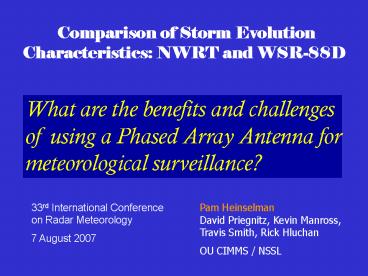Phased Array Radar - PowerPoint PPT Presentation
1 / 11
Title: Phased Array Radar
1
Comparison of Storm Evolution Characteristics
NWRT and WSR-88D
What are the benefits and challenges of using a
Phased Array Antenna for meteorological
surveillance?
33rd International Conference
on Radar Meteorology 7 August 2007
Pam Heinselman David
Priegnitz, Kevin Manross, Travis Smith, Rick
Hluchan OU CIMMS / NSSL
2
Advantage of NWRT Phased Array Radar Faster Scan
Rates
Ultimate Goal
What we have now
3
Advantage of NWRT Phased Array Radar Adaptable
Scan Capability
Radar Control Interface with VCP selector open
4
Phased Array Radar WSR-88D
Comparison
Similarities
Wavelength (9.4 cm) Range Resolution (250
m) Can mimic WSR-88D VCPs
5
Earlier confirmation of intensifying/contracting
gust front
223346 UTC
24 April 2006
PAR VCP 12 clone 90? sector
Images 58 s
WSR-88D VCP 12
Images 4.1 min
6
Earlier confirmation of
reintensifying supercell
223346 UTC
Max vorticity gt .0075 s-1
7
Better coherence
in circulations
PAR
PAR
PAR VCP 12 clone
45? sector Images 30 s
KTLX
KTLX
WSR-88D VCP 12
Images 4.1 min
8
Earlier detection of
tornadic vortex signature
PAR
PAR
Union City, OK Tornado (5/9/07)
PAR VCP 12 clone
45? sector Images 30 s
KTLX
KTLX
WSR-88D VCP 12
Images 4.1 min
9
Earlier detection of large hail aloft
223346 UTC
15 August 2006
PAR Reflectivity cross-section, cappi (10 km),
and 0.5? PPI 31 elevation scans up
to 41?, 831 ?s PRT 90? sector
Images 26 s
Simulated WSR-88D Reflectivity cross-section,
cappi (10 km), and 0.5? PPI Images 5 min
10
Earlier detection of microburst
223346 UTC
10 July 2006
PAR VCP 12 clone 90? sector
Images 34 s
WSR-88D VCP 12
Images 4.1 min
11
PAR Benefits Challenges
- Benefits
- Challenges
- Allows focus on high-impact events
- More timely data interpretation
decision-making - Improved confidence in feature location,
intensity, and evolution - Potential to improve algorithm performance
- Choosing sector location
- Cognitive overload
- Understanding small-scale transient phenomena
that are not observed regularly in WSR-88D data - Radar hardware and display software limitations































